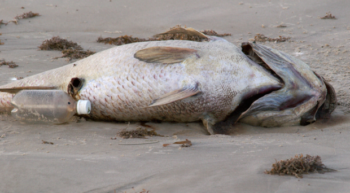[dropcap]A[/dropcap] rare red tide has spread across waters off the Florida Keys, likely triggering numerous fish kills reported by anglers.
Florida Fish and Wildlife Conservation Commission scientists began tracking Karenia brevis, the algae that makes up red tide, in southwest Florida north of Monroe County several months ago. On Feb. 19, they reported elevated levels near Sandy Key on the western edge of Florida Bay.

Red tide can kill fish, cause respiratory problems and make shellfish dangerous to eat.
Red tide can kill fish, cause respiratory problems and make shellfish dangerous to eat.
Wind and current likely carried the tide from the north, said FWC spokeswoman Michelle Kerr.
Over the last month, anglers reported seeing large fish kills, although it’s still not clear the algae killed the fish, that included grunts, small eels, trout and cowfish, along with bigger barracuda and ladyfish. The dead fish were spotted west of Marathon and from Sandy Key to Islamorada. Commercial fishermen and guides, already struggling after Hurricane Irma slammed the Lower Keys, were not taking the news well.






